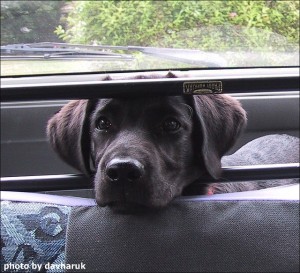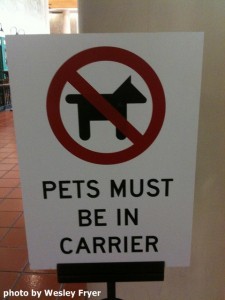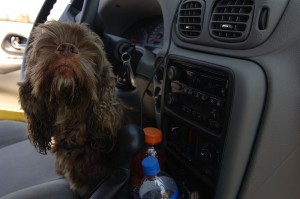
Over 10 million Americans travel with their pets every year, according to the Travel Industry Association of America (TIA). Most of the travel (76%) is done by car, but that still leaves a whooping 2.4 million pets flying somewhere every year.
When it comes to traveling, sometimes it’s the simplest and most basic mistakes that put your pets at risk. So if you already know what to do to keep your pet safe, maybe it’s time to learn what not to do.
1. Don’t give your pet a sedative. “Many people think it might be easier to tranquilize a pet during a trip, but this isn’t a good idea,” says Caitlin Moore from PetRelocation.com. “Sedatives alter your pet’s ability to stabilize themselves and may affect breathing and overall health.” Sedatives can also cause an animal’s temperature to drop too low. This can be dangerous in cold weather, but it can also cause shock and not allow the animal to wake up again. Some animals become stimulated when they receive sedation. As a result, the medicine might not work until hours later, when you’re already at your destination.
2. Don’t feed your pet right before a trip. If you have a long flight (or car ride) ahead, you might be tempted to feed your dog right before “so he doesn’t go hungry”. This is a bad idea for a number of reasons. According to pet lifestyle expert and author Sandy Robins, our pets, just like people, often suffer from motion sickness and thus it’s a good idea to refrain from feeding them to avoid problems. “If you are going to feed your pet, make sure it is a light meal,” says Robins. On the other hand, don’t forget to keep your pet hydrated. A block of ice is usually better than water, especially during a flight. Just put the block of ice into the feeding bowl so the animal can lick it as it melts.
3. Don’t fly when it’s too hot or too cold. In winter, fly during the day (warmer); in summer, fly early morning or late at night. Some breeds (short hair, pug noses) are especially sensitive to temperature changes.
 4. Don’t take your pet out of the carrier. Even the tamest, most mellow animal might “freak out” and end up escaping. “In unfamiliar surroundings, your pet may react unpredictably, as stress can cause even well behaved pets to growl, hiss or bolt,” says Janice Costa, the owner of Canine Camp Getaway in upstate New York. If you’re traveling with a cat, don’t let him out of the carrier unless you’re in a hotel room and all the windows and doors are securely closed.
4. Don’t take your pet out of the carrier. Even the tamest, most mellow animal might “freak out” and end up escaping. “In unfamiliar surroundings, your pet may react unpredictably, as stress can cause even well behaved pets to growl, hiss or bolt,” says Janice Costa, the owner of Canine Camp Getaway in upstate New York. If you’re traveling with a cat, don’t let him out of the carrier unless you’re in a hotel room and all the windows and doors are securely closed.
5. Don’t rely on the airline to give you anything. If your animal is flying with a pet carrier, then it’s likely the airline might provide you with things you forgot. Otherwise, don’t count on a regular airline to give you things like Live Animal stickers, water dishes or soft absorbable bedding. Make sure you get everything else in advance. If you show up at the airport and you’re missing something, your pet might be refused.
6. Don’t leave your pet unattended for long periods of time. This doesn’t mean only inside cars, but also hotel rooms, strange places or even parks or open spaces. In a strange environment, your absence can cause extreme stress, which can result in barking, howling, chewing, scratching or other destructive behaviors. If you’re traveling with your pet, Costa recommends either planning activities you can enjoy together (hiking, cuddle time) or considering a vacation that has pre-planned pet activities with other pet lovers. “Exercise is a great stress reliever,” says Costa, “so build time into your trip for some pet playtime. If you’re planning a trip where you’ll need to be out for long periods of time, you may be better off leaving your pet at home with a trusted friend or sitter.
7. Don’t transport your pet if he is too young, injured or sick. Most airlines require puppies and kittens to be at least four weeks old before they fly. If you can wait a bit longer, that’s even better. PetRecolocation won’t fly any animals until they’re at least eight weeks old. Sick and injured animals need extra care and most airlines won’t even allow these passengers. If you’re traveling by car, talk to your vet and have a contingency plan in place before you go. You should also have the name and phone numbers of vets and emergency services along the way.
8. Don’t forget the small details. Always bring your pet’s favorite toy or blanket with you or pack it inside the carrier for a flight. This will help ease your pet’s anxiety and make the trip smoother. Also, make sure you start planning your trip well in advance, especially if you need vaccines or certificates for international travel. If your pet isn’t crate-trained, Moore recommends getting your pet acquainted with the crate by keeping it in a common area in the house, placing toys in it, and making it the place where your pet eats. 
9. Don’t think there’s such thing as “too much” when it comes to pet identification. Put identification information everywhere. A secured collar with an ID tag is just the first step. Tie a luggage tag with your information to the pet carrier’s door and add a sticker to the side of the carrier so you can also write the information there. Also, it’s important to microchip your pets, whether or not it’s required by your country of destination or travel carrier. “Hopefully you’ll never deal with a situation where your pet becomes lost, but just in case, be sure to carry a recent photo in your wallet or on your smartphone should you end up having to track them down,” says Moore.
10. Don’t assume a place is pet friendly. Even your friends’ houses can be dangerous if they’re not pet-proof. If you’re renting a room, check inadvance, as hotel policies can change. The last thing you want to have happen is end up at a destination only to be told your dog can’t stay with you. “Some hotels that claim to be pet-friendly have numerous restrictions, and may exclude multiple pets, pets over a certain weight, or pets of a certain type or breed,” according to Costa.
Above all, always be prepared. Emergencies happen. Before you head out, Costa recommends finding the 24-hour veterinary hospital nearest to where you’ll be staying and program it into your cell phone and navigation unit. “If your pet unexpectedly falls ill or is injured, you won’t have to waste precious time looking up numbers or directions,” says Costa.


